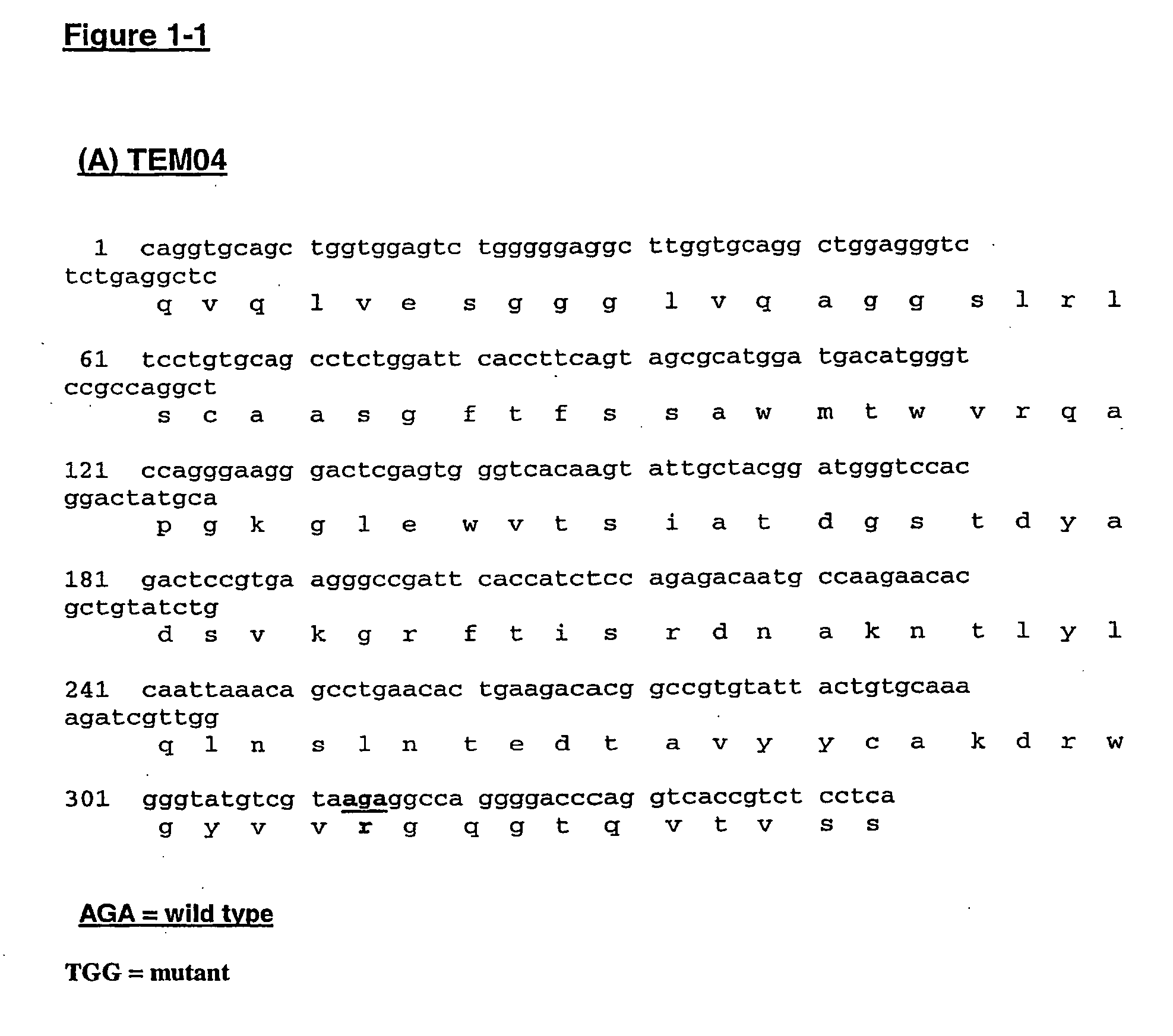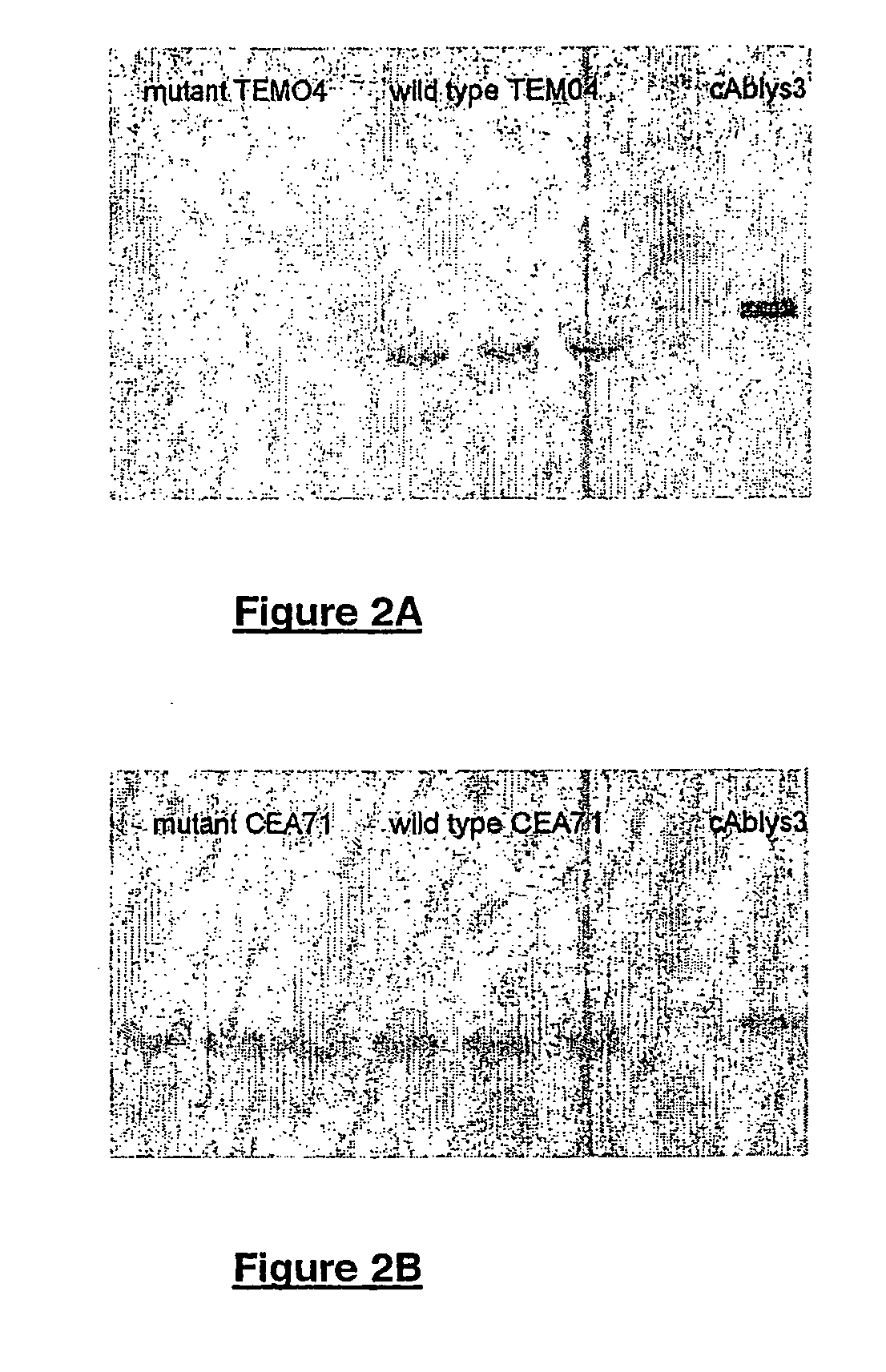Functional heavy chain antibodies, fragments thereof, library thereof and methods of production thereof
a technology fragments, which is applied in the field of functional heavy chain antibodies, fragments thereof and a library thereof, can solve the problems of increasing the solubility of a single domain heavy chain antibody fragment, and the production of antibodies, for example by phage display libraries, is technically difficult, and achieves improved expression levels, affinity and solubility, and improved properties.
- Summary
- Abstract
- Description
- Claims
- Application Information
AI Technical Summary
Benefits of technology
Problems solved by technology
Method used
Image
Examples
example 1
Camelization of Isolated VH1
[0284] Classically, a recombinant VH domain is isolated from scFv libraries. Such VH domains usually originate from a cloning artifact for example by the cloning of VH instead of VH-VL, or they may originate from a gene recombination within the clone, due for example to instability of the linker sequences, resulting in the deletion of the VL gene fragment. These molecules are normally difficult to work with because of their low expression yields in, for example, bacterial and other expression systems and their low solubility. The inventors show that these VH molecules may be better expressed and show a higher solubility by introducing a mutation changing the Trp on position 103 into Arg. This is a much easier and more straightforward mutation than Val37Phe, Gly44Glu, Leu45Arg and Trp47Gly or part of it as originally carried out by Davies and Riechmann (1994). It has the additional advantage that it could be performed on all VH sequences, not only of huma...
example 2
Generation of Soluble Single Domain from a scFv Antigen Binding Fragment
[0285] In cases where a minimal size of the antigen binding fragment is envisaged, it might be an advantage to design a single domain from an existing scFv. The VH domain has specific interest since this domain, in principle, provides specificity and is the largest contributor to affinity. Single domains have further advantages due to their smaller size. Although it has been repeatedly shown that VH domains retain sufficient activity to interact with antigen, VH domains are known to be sticky and insoluble. The present invention shows that these problems can be remedied by the Trp103Arg substitution.
example 3
Effect of Arg103Trp Mutation on Solubility and Antigen Binding of VHH
[0286] 3.1 Production and Purification of Wild Type and Mutant VHH.
[0287] The gene fragment encoding the anti-β-lactamase VHH TEM04 was mutagenized by PCR using the FR4 specific primer A4short-TEM04 (5′-GGA GAC GGT GAC CTG GGT CCC CTG GCC CCA TAC GAC-3′) (SEQ ID NO: 96) thereby changing the wild type residue Arg on position 103 to Trp103. Using a similar approach, the anti-carcinoembryonic antigen (CEA) VHH CEA71, was mutated with primer A4short-CEAVH (5′-GGA GAC GGT GAC CTG GGT CCC CTG GCC CCA GGG GC-3′) (SEQ ID NO: 97).
[0288] The E. coli production vector pHEN6 was used for expression of the wild type and mutated VHH fragments. pHEN6 is derived from pHEN1 (Hoogenboom et al. (1991)), pHEN6 encoding the hexahistidine tag sequence for purification of VHH and lacking the phage M13 gene3. The PCR-products and vector were digested with Ncol-BstEll and loaded on a 1% agarose gel. Fragments and vector were purified fr...
PUM
| Property | Measurement | Unit |
|---|---|---|
| pH | aaaaa | aaaaa |
| concentration | aaaaa | aaaaa |
| temperature | aaaaa | aaaaa |
Abstract
Description
Claims
Application Information
 Login to View More
Login to View More - R&D
- Intellectual Property
- Life Sciences
- Materials
- Tech Scout
- Unparalleled Data Quality
- Higher Quality Content
- 60% Fewer Hallucinations
Browse by: Latest US Patents, China's latest patents, Technical Efficacy Thesaurus, Application Domain, Technology Topic, Popular Technical Reports.
© 2025 PatSnap. All rights reserved.Legal|Privacy policy|Modern Slavery Act Transparency Statement|Sitemap|About US| Contact US: help@patsnap.com



